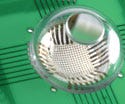Electronic Eye Sets the Curve
R&D DIGEST
September 1, 2008
|
According to its inventors, this eye-shaped camera is a major move toward the bionic eye. |
A team of researchers has created an electronic camera that focuses images on a curved, hemispherical surface. The technology behind this eye-shaped imaging device could drive new developments for bionic implants, robotic sensory skins, and biomedical monitoring devices.
Researchers at Northwestern University and the University of Illinois at Urbana-Champaign have created a camera made of silicon light-detectors. It is inspired by the human eye and mimics the eye's method of focusing light onto a curved surface—a stumbling block for current imaging technology. Conventional cameras use a curved lens to focus light onto a flat surface.
Work on the device began about three years ago, after the researchers came up with methods to create silicon electronics and optoelectronics in elastic, stretchable configurations. The added flexibility was critical.
“The advantages of hemispherical detector arrays for imaging systems are well known, and the goal of an electronic eye–type camera that incorporates such a design has been a target of research efforts for more than 20 years,” says John Rogers, a team member at the University of Illinois at Urbana-Champaign. “We believed that our stretchable technology would allow, for the first time, experimental realization of this kind of camera.”
Researchers have tried a variety of methods to get around the rigidity of traditional electronic materials, which typically break when they are bent. To create lenses for the device, the team used a network of silicon photodetectors put together in a deformable mesh. The detectors are connected by flexible ribbon cables, which are 1–2 µm thick. The components are then covered in a thin polyimide film, which enables the materials to bend when compressed. The plastic film protects the electronic assembly as the array takes on a hemispherical shape.
Rogers says that there are still plans to tweak the technology and make it reproducible. “We now have concepts that enable the fabrication of eye cameras in reproducible processes. The present devices incorporate arrays with modest numbers of pixel elements,” Rogers says. The camera works with about 256 pixels now. Theoretically, the same methods can be applied to arrays with much higher resolution, he says.
“These technologies create new opportunities for using established, planar electronics in ways that could be extremely useful for biomedical applications,” Rogers says.
Currently, the team is collaborating with the medical school at the University of Pennsylvania to build devices for monitoring the electrical activity of the brain, and for stimulating the heart. The researchers are also working with venture capitalists in the Boston area to develop methods of commercializing the technology.
Copyright ©2008 Medical Device & Diagnostic Industry
About the Author(s)
You May Also Like


.png?width=300&auto=webp&quality=80&disable=upscale)
